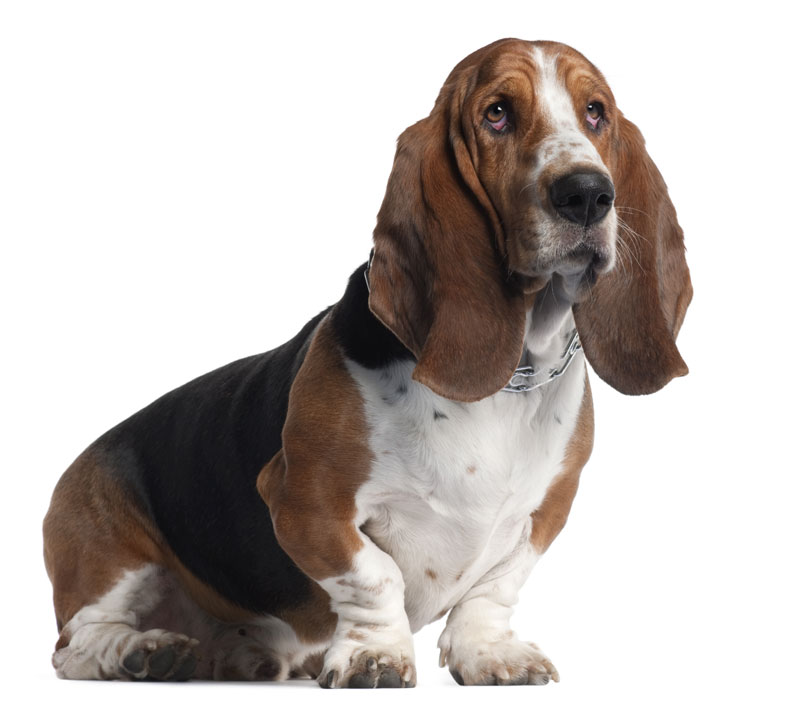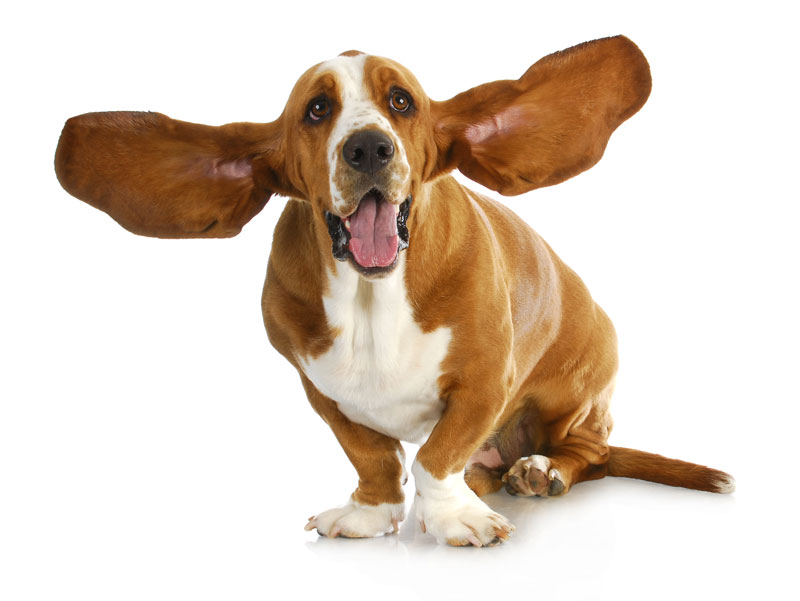The Basset Hound is a short-legged dog breed of dog of the hound family, as well as one of six recognized Basset breeds in France; furthermore, Bassets are scent hounds that were originally bred for the purpose of hunting rabbits and hare. Their sense of smell for tracking is second only to that of the Bloodhound.
The name Basset is derived from the French word bas, meaning "low", with the attenuating suffix -et, together meaning "rather low". Basset Hounds are usually Coat_(dog)#Patterns or Coat_(dog)#Patterns of standard hound coloration.
Health
Ears
Basset Hounds have large pendulant ears (known as "leathers") that do not allow air to circulate inside them, like other breeds with erect or more open ears. This can result in Otitis media and ear mites if their ears are not kept clean and dry. If their ears are allowed to dangle on the ground or in food on a daily basis, they may develop chronic and potentially fatal ear diseases. Young puppies trip over their long ears and may bite their ears accidentally if they dangle in their food. This can lead to infection if they break the skin. Regular cleaning of the inside and outside of the ears, including the removal of excess ear wax, is necessary to prevent infections.
Short Stature
The Basset Hound's short stature is due to a genetic condition known as Osteochondrodysplasia (meaning abnormal growth of both bone and cartilage). Dwarfism of this type in most animals is traditionally known as Achondroplasia. Basset Hounds, Dachshunds and Bulldogs are a few of the dog breeds classified as Achondroplastic.Basset Hound puppies or very old dogs, should not be allowed to jump down from a height, due to how low they are to the ground. Because of a basset's body build (short stubby legs, low to the ground), if they fall too far, they can hurt their hips, injure their spine or break a leg. Many aging bassets have been euthanized due to such injuries. If a puppy sustains one of these injuries, the damage can be permanent.
Other
In addition to ear problems, basset hounds may be susceptible to eye issues. Because of their droopy eyes, the area under the eyeball will collect dirt and become clogged with a mucus. It is best to wipe their eyes every day with a damp cloth. This helps to lessen the build-up and prevent eye irritation.Bassets are bred for endurance. They need plenty of exercise and a good diet, free of grains and fillers to avoid potential food allergies and skin conditions. Being overweight leads to paralysis in Bassets.Basset Hounds are prone to yeast infections in the folds around the mouth, where drool can collect without thoroughly drying out. Wiping the area with a clean, dry towel and applying talcum powder can minimize this risk.The only recent mortality and morbidity surveys of Basset Hounds are from the UK: a 1999 longevity survey with a small sample size of 10 deceased dogs and a 2004 UK Kennel Club health survey with a larger sample size of 142 deceased dogs and 226 live dogs. See Mortality and Morbidity below.
Mortality
Median longevity of Basset Hounds in the UK is about 11.3 years, The oldest of the 142 deceased dogs in the 2004 UK Kennel Club survey was 16.7 years. Mummified remains of short-legged dogs from that period have been uncovered in the Dog Catacombs of Saqqara, Egypt. Scent Hounds were used for hunting in both Ancient Greece and Ancient Rome.
St Hubert's Hound
The basset type originated in France, and is descended from the 6th century hounds belonging to St Hubert of Belgium, which through breeding at the Benedictine Abbey of Saint-Hubert, Belgium eventually became what is known as the Bloodhound#Chien_de_St_Hubert around 1000AD. St Hubert's original hounds are descended from the Laconian (Spartas) Hound, one of four groups of dogs discerned from Greek representations and descriptions. These scent hounds were described as large, slow, 'short-legged and deep mouthed' dogs with a small head, straight nose, upright ears and long neck, and either tan with white markings or black with tan markings.
Laconian Hounds were reputed to not give up the scent until they found their prey. They eventually found their way to Constantinople, and from there to Europe. and for this reason short-legged dogs were highly valued for hunting on foot.Basset type hounds achieved noticeable public cultural popularity during the reign of Emperor Napoleon III (r. 1852-1870). In 1853, Emmanuel Fremiet, "the leading sculptor of animals in his day" exhibited bronze sculptures of Emperor Napoleon III's basset hounds at the Paris Salon. Ten years later in 1863 at the first exhibition of dogs held in Paris, basset hounds attained international attention.The controlled breeding of the short haired basset began in France in the year 1870. From the existing Bassets, Count Le Couteulx of Canteleu fixed a utilitarian type with straight front legs known as the Chien d'Artois, whereas Mr. Louis Lane developed a more spectacular type, with crooked front legs, known as the Basset Normand. These were bred together to create the original Basset Artésien Normand.
England
French bassets were being imported into England at least as early as the 1870s. While some of these dogs were certainly Basset Artésien Normands, by the 1880s linebreeding had thrown back to a different heavier type. Everett Millais', who is considered to be the father of the modern Basset Hound, bred one such dog, Nicholas, to a Bloodhound bitch named Inoculation through artificial insemination in order to create a heavier basset in England in the 1890s. The litter was delivered by caesarean section, and the surviving pups were refined with French and English bassets. The first breed standard for what is now known as the Basset Hound was made in Great Britain at the end of 19th century. This standard was updated in 2010.









